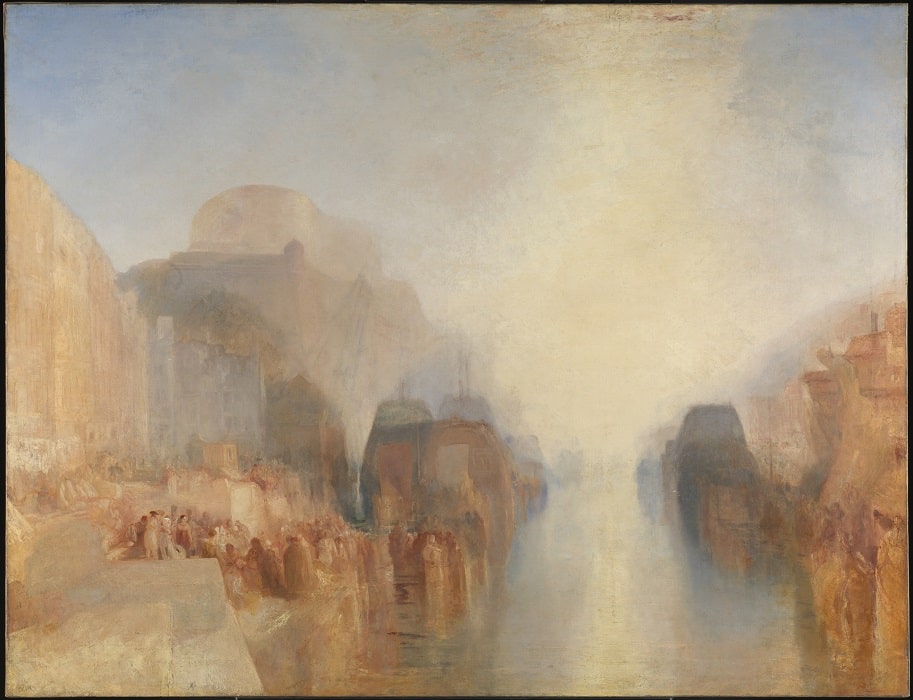The exhibition Three Horizons is organised by Lenbachhaus in cooperation with Tate, London Lenbachhaus, Kunstbau.
Fig. above: Snow Storm – Steam-Boat off a Harbour’s Mouth / Schneesturm – Ein Dampfschiff im flachen Wasser vor einer Hafeneinfahrt, exhibited 1842 / ausgestellt 1842, Joseph Mallord William Turner (1775-1851). Tate: Accepted by the nation as part of the Turner Bequest 1856 © Photo / Foto Tate
Joseph Mallord William Turner (1775-1851) is still regarded as an innovator of landscape painting and a pioneer of modernism. In his paintings, colour unfolded with a previously unseen freedom. Turner attracted attention at an early age with his landscape and architectural drawings and was awarded a scholarship to the Royal Academy of Arts in London at the age of 14. As there was no chair for landscape painting there – it was not considered an academic genre until the 19th century – Turner acquired his knowledge and techniques himself: through intensive study of nature and famous artistic models. Always equipped with a sketchbook, he not only went into the British countryside, but travelled all over Europe and made numerous sketches, which he transformed into oils or watercolours in the studio. This immediacy of his experience of nature is expressed in his works. Even more: his paintings document their time of origin and reflect a world in rapid change. While in the seascape Entrance of the Meuse (1819) a sailing ship becomes the plaything of the waves, in Snow Storm (1842) it is a steamship that gets caught in a snowstorm – both pictures are on show in the exhibition. Regardless of whether Turner takes on mythological, historical or contemporary themes, nature is always the dominant motif. Especially the rendering of weather and atmosphere is in focus and testifies to his interest in the natural sciences. In an attempt to capture the overwhelming nature, Turner also refers to Edmund Burke’s philosophical concept of the “sublime”.

In his artistic endeavour to give expression to an experience of nature that encompassed all the senses, he increasingly pushed the boundaries of what could be depicted. Soon his works became so clearly detached from nature that their reduction to colour and light called the depictive function of the image into question. Turner thus astonished and provoked his contemporaries: The art critic William Hazlitt thought that the later pictures abstracted too much from the natural object. For his younger colleague John Ruskin, on the other hand, it was clear: “Turner is like nature, and paints more of nature than any man who ever lived. It was precisely this contradictory reception that shaped Turner’s reputation as a precursor of abstraction.

Turner was not uninvolved in this long-lasting myth. On the contrary: the exhibition Three Horizons explores the question of how the artist educated and staged himself. It is devoted to his unofficial experiments away from the public eye as well as his self-representation, such as at exhibitions at the Royal Academy in London. The collection of 100 of his own works he curated during his lifetime (part of the later Turner Bequest), which he bequeathed to the public as a gift, was part of this very strategy. But the road to success was not easy for Turner, who came from a humble background, and was accompanied by numerous failures. His less successful teaching at the Academy, for example, was often criticised because of his “poor” talent for oratory, although the lecture diagrams created for it and presented in the exhibition aptly visualise approaches to perspective theory.

The exhibition Three Horizons – a reference to Three Seascapes (ca. 1827), in which, depending on the angle of view, three or even four views of the sea merge into one another – aims to explore the phenomenon of Turner from three perspectives: The “official” Turner, who positioned himself in the London art scene with his exhibition paintings; the private Turner, whose artistic experiments helped him to overcome conventions and produce abstract-looking paintings; and, in third place, the reception history of his entire oeuvre, which ranges from Ruskin’s euphoria to Hazlitt’s criticism to the 20th-century narrative of Turner as the first modern painter. The fact that all three of these aspects cannot be strictly separated from each other, but rather intertwine in a similar way to the landscapes in Three Seascapes, becomes clear in the course of the exhibition.

It has been a long-cherished wish of the Lenbachhaus to be able to show Turner’s work in all its breadth in its ongoing research into the history of abstraction. Thanks to the cooperation with Tate Britain, London, which preserves his rich estate, Turner’s career and his pictorial innovations become vividly comprehensible. The Turner Bequest, which came into public possession in its entirety five years after the artist’s death in 1851 and has been administered by Tate as part of the national art collection since 1910, comprises 300 oil paintings as well as several thousand sketches and watercolour works: While the collection of paintings covers the entire spectrum of Turner’s oil works and includes early experiments, large-scale exhibits and his late work often described as “impressionistic”, the collected drawings, watercolours and sketchbooks provide a deep insight into his working methods. From this world’s largest Turner collection, we are showing around 40 paintings as well as 40 watercolours and sketches from all phases of his work.
Curated by Karin Althaus and Nicholas Maniu
WHERE?
Municipal Gallery in the Lenbachhaus and Kunstbau Munich
Luisenstraße 33
80333 München
WHEN?
Tuesday to Sunday and public holidays: 10am-6pm
Thursday: 10-20 h
Monday: closed
COSTS?
Regular: 10 euros
Reduced: 5 euros
The audio guide is included in the price.
Every first Thursday of the month
from 6 to 10 p.m. free admission






